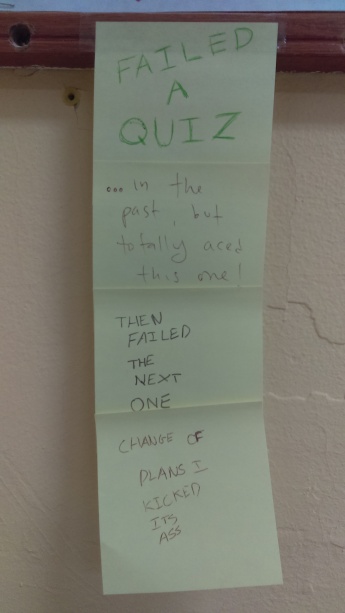2016 Blogging Initiative: Week 4

Alright, so here we are. The end of the initiative, which means the continuation of my posting is uncertain. For one, it’s a time investment and time is something that is in extremely short supply in my life. For another, I’m by-and-large uninspired. This is a theme that’s been noticeable since I was in high school. Give me a prompt and I can produce pretty much anything. But if I have to prompt myself, I just ruminate and stagnate. Terrible, I know.
Anyhow, this week wasn’t super exciting for any of my classes. My algebra 2 kids are working on building intuition about quadratics and my calculus kids are doing a bunch of work with implicit differentiation. So that leaves my precalc kids, who are developing the unit circle from the ground up. It’s a bit of a slog and mostly involves conversing with them and drawing lots of pictures together. So sorta hard to translate here, but…
Last week they came up with radians as a unit of angle measure (using strings and paper plates), so at the beginning of this week I had them derive the formulas for arc length and sector area. In theory this is geometry, not so much trig, but it’s a good opportunity for them to get their brains working in radian mode and start picking apart a couple of the places that will get them into trouble down the line, conceptually, if we don’t start bumping up against them now.
Warm Up: PREC WU40
At this point they’ve completed a homework where they used the formulas they generated in the previous week for converting between different types of angle measures. I like this one because most of them were able to think through it without grabbing their conversion notes or using a calculator. They’ve gotten the hang of 2π being a full circle, so it’s pretty uncomplicated to convert the degrees to revolutions and then the revolutions to radians. Also, they’re amused by the photo evidence I’ve provided of my skateboarding years.
Correct Homework: PREC HW39
Not an imperative part of the lesson here, but this is where they check all those repetitive conversions they did over the weekend. Partner-up-and-lemme-know-if-you-have-any-unanswered-questions type of thing. Clarify that it’s usually best to leave radian measurements with the π still in there and simplify the fraction, rather than a number with weird random decimals (which about half of them did as a result of just typing stuff into the calculator).
Classwork: PREC CW40
Earlier in the previous week they derived the formulas for circumference and area on their own by measuring stuff, cutting up stuff, etc. I provided them again and gave them the definitions for arc length and sector area, with visuals to demonstrate. Pose the question and let it sit. Lots of protests arise.
“But it depends on the angle!”
“I don’t know the angle!”
“I don’t know how to do this!”
Push back. Bite tongue. Some ideas start trickling out.
“Oh, wait, I think I know how to do this.”
They come up with a way different than I was thinking, but it works the same, which is always a great moment for me. My thought was to find the percentage of the given angle to the whole circle, then multiply it by the circumference/area of the whole circle. They set up a proportion. The angle out of the whole circle is equal to the arc/sector out of the whole circumference/area. Then they isolate the unknown (in this case, the angle measure). They look over their results and the wheels start turning.
“Huh… That’s weird…”
“The formula for radians is so much simpler than degrees.”
“Why did that happen?”
YES! Point made, without having to say it. Flip over page for explanation. Kids tell me that I’m turning into the science teacher because I put too many comics on things.
Homework: PREC HW40
Here’s what I like about this one. Some of the kids tell me that they can just find the circumference/area for the whole circle, then divide it into however many parts. They think they’re being sneaky, by avoiding using the formulas. I don’t care if they use the formulas or not for this assignment. Like I said, it’s basically geometry anyway. I just want to reinforce the connection that sections of circles are proportional to whole circles, and more importantly, start getting them thinking about the difference between angle inputs and numerical outputs. It worked pretty much perfectly. Before the next class I had a kid come to me and ask, “Should I calculate parts (c) and (d) using degrees or radians?” The conversation that came out of that was really valuable. It doesn’t matter which one you use! Either is fine (provided you go about it carefully if you are using formulas). The arc length is the arc length, no matter how you measure the angle. The area is the area, no matter how you measure the angle. Spoiler alert: The sine/cosine are the the sine/cosine, no matter how you measure the angle.
I’m glossing over some issues here. The biggest one is that I only have 4 kids in this class and 1 was absent, 1 was super late, and 1 was with the college counselor for half the class. So the pacing wasn’t as it should be, which means things have to get shifted and tweaked (e.g. kids can’t check answers together, so instead, I look over individual kids’ homework while they work on the warm up… which happened 3 different times that day as kids filtered in). I wanted to show the Anti-Pi Rant from Vi Hart, but with the timeliness issues, it just didn’t happen.
Also, we have short classes. Only 40 minutes and we have no passing period, so classes go bell-to-bell with nothing in between. Which means the first several minutes are lost to kids getting themselves to me, sitting down, getting stuff out, etc. Also, at the end of class kids have to record assignments and I have to sign all their planbooks, so that eats a little time. Let’s call it a net of 35 minutes of available productive time. Really not very much, if this seems a bit sparse for a lesson.
Lastly, I had the PE teacher in my class that day, doing a peer-to-peer observation. The kids kept throwing me confused looks, nodding slyly in the direction of the back of the room, trying to figure out what was going on. As soon as he left, they went bonkers.
“What was that?!”
“Why was he here?”
We demand answers! The ambiance of a class is always slightly (or significantly) different with another person there, so who knows exactly how things would’ve played out if it had just been the usual crowd?
Despite the fact that things didn’t logistically work out the way they were meant to, I think I can say with a reasonable degree of certainty that the objectives weren’t substantially compromised. Not the most stimulating lesson, but far from the least. Probably fair to say that this day represented average student engagement and average student learning. I feel pretty okay with average, at this point.
Comments? Critiques? Improvements? Let me know!



